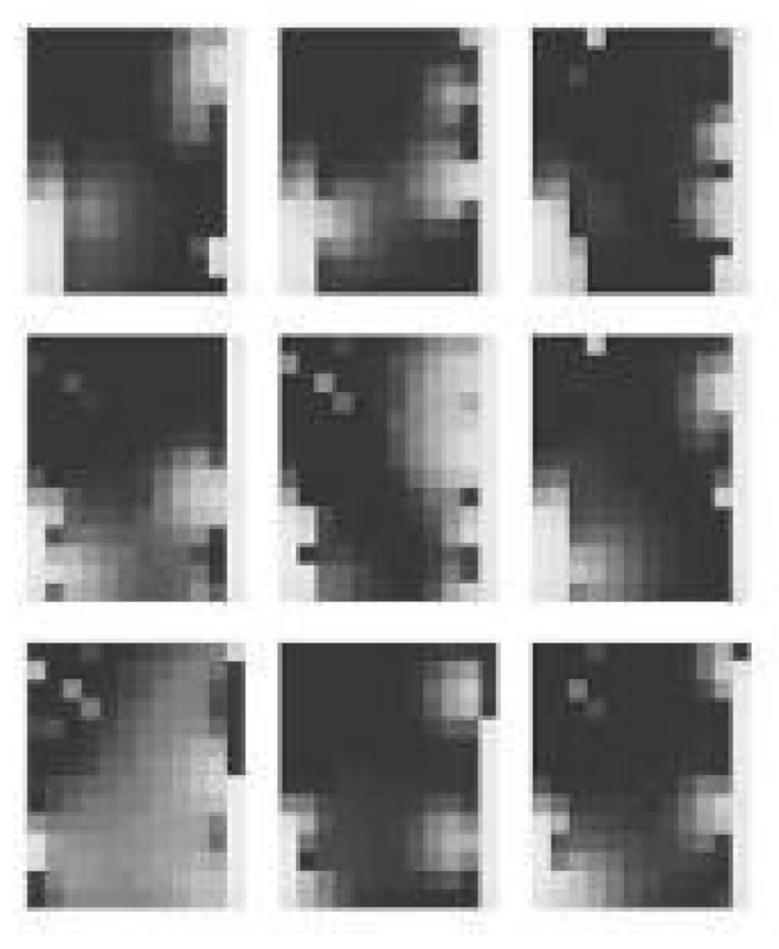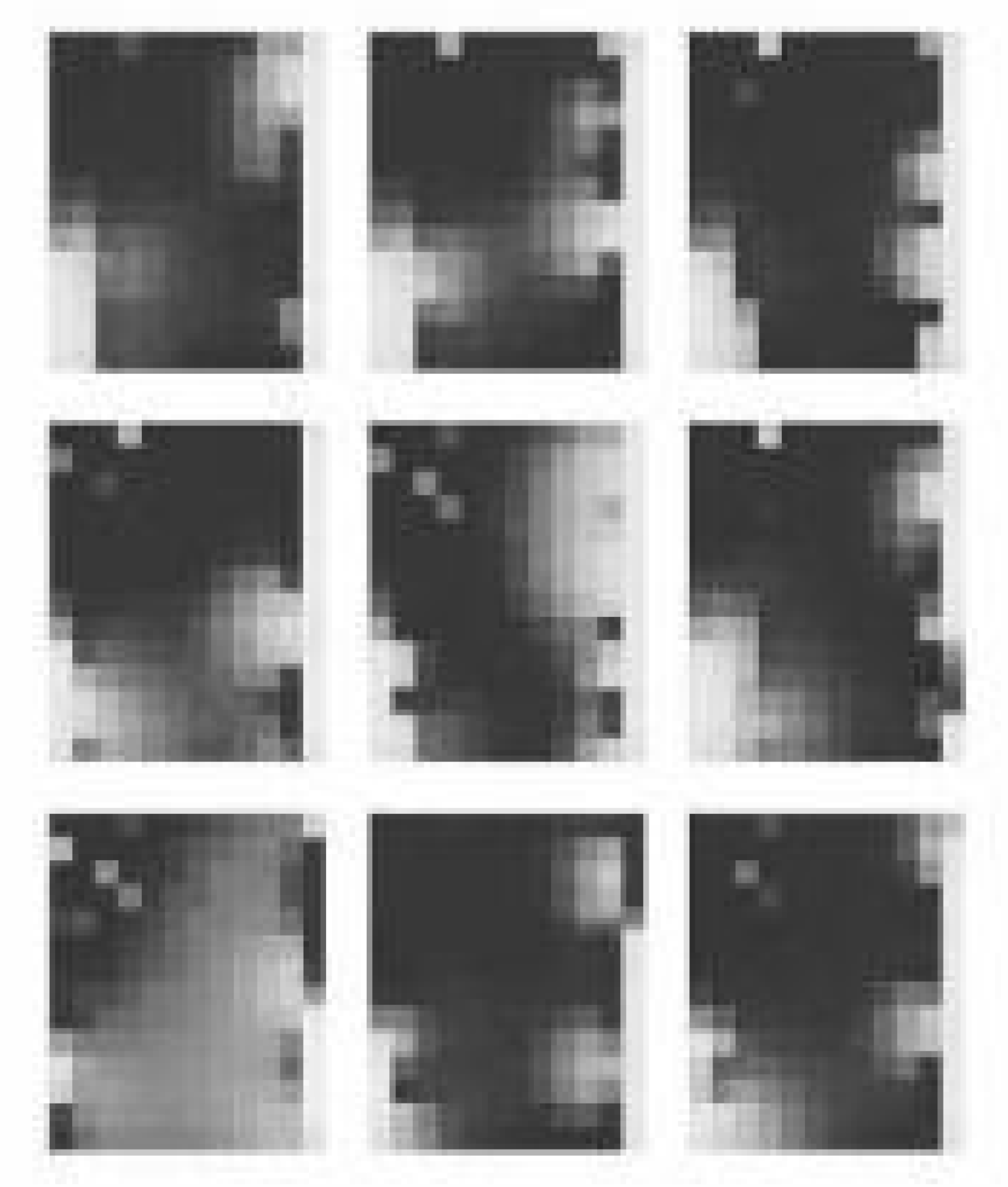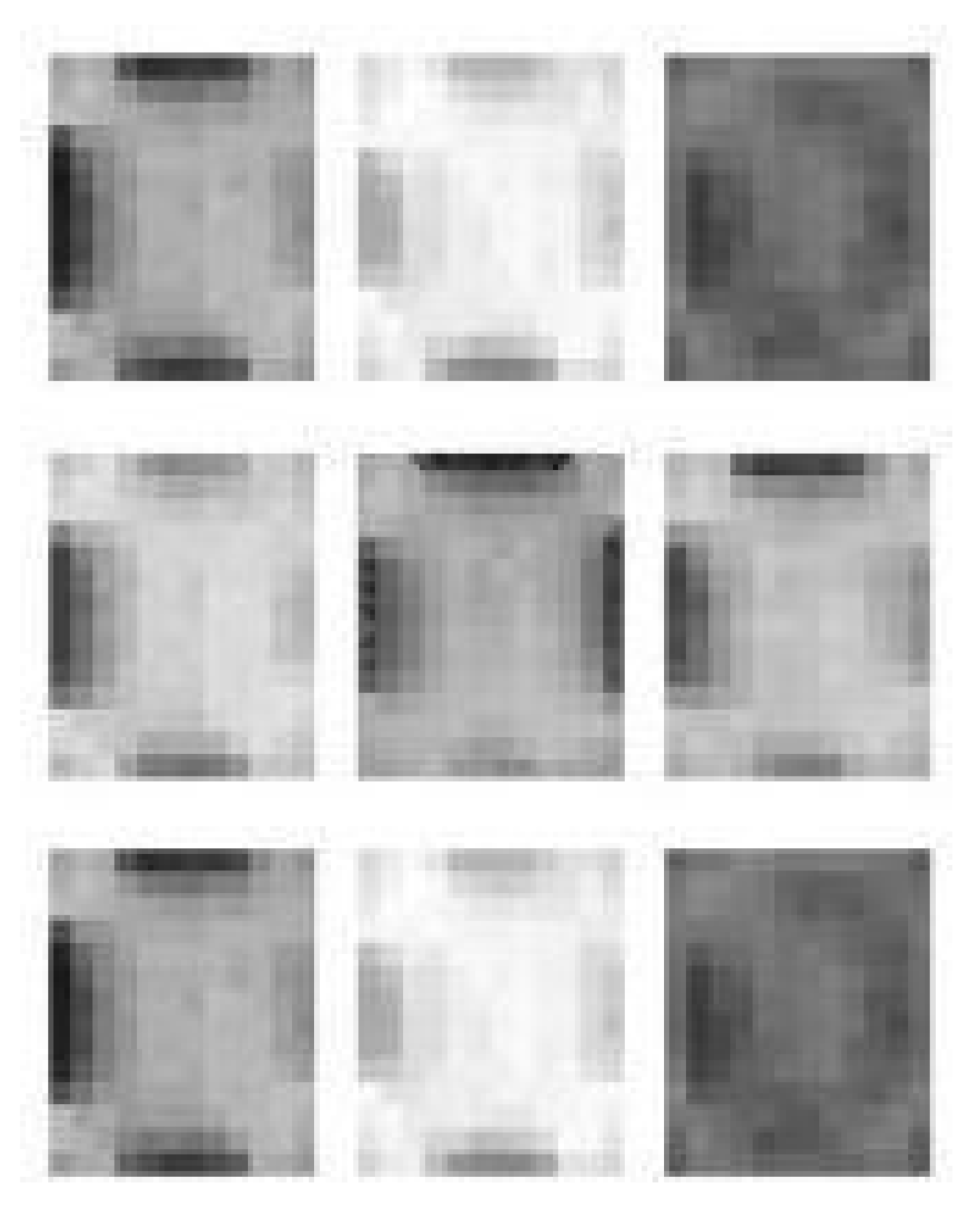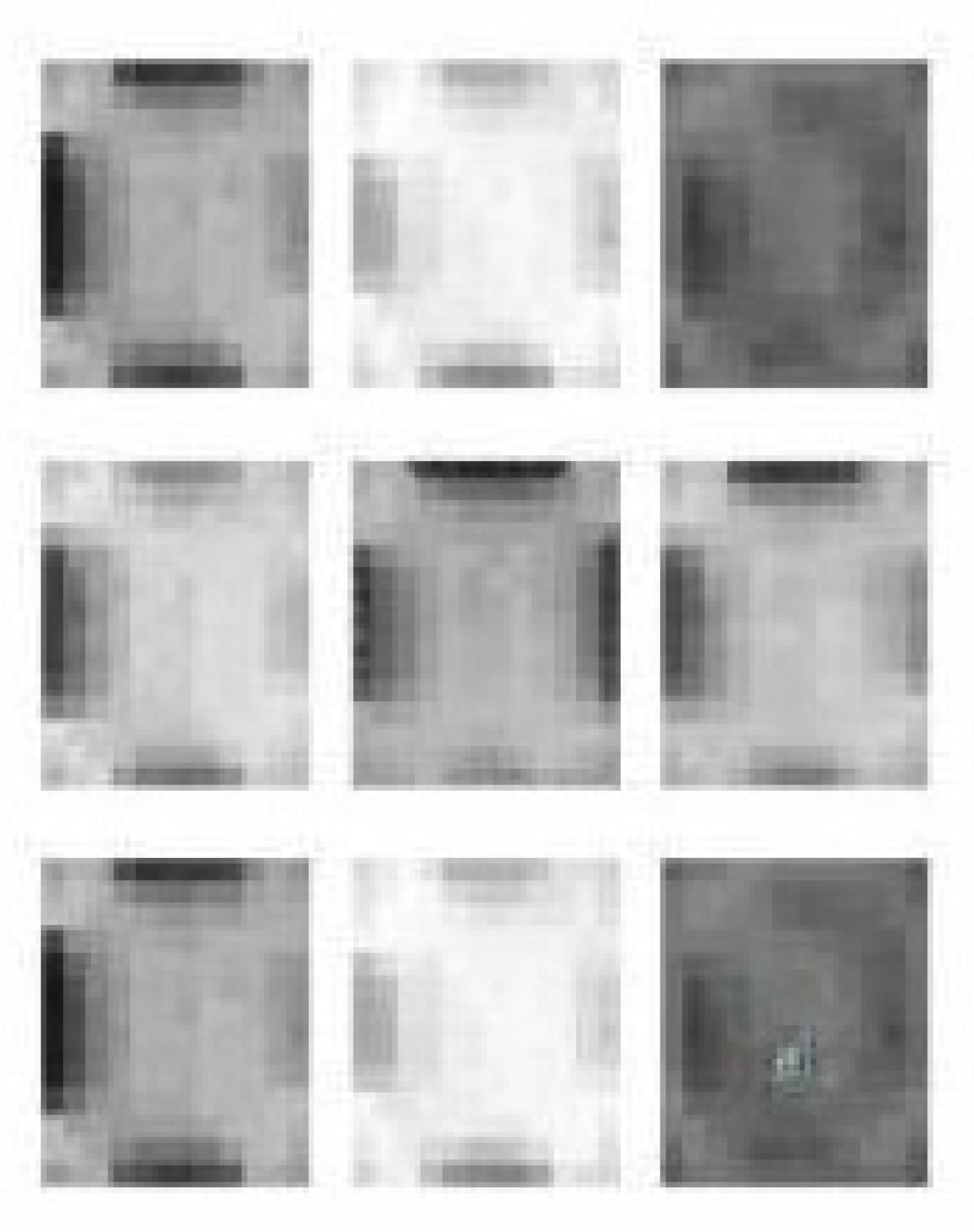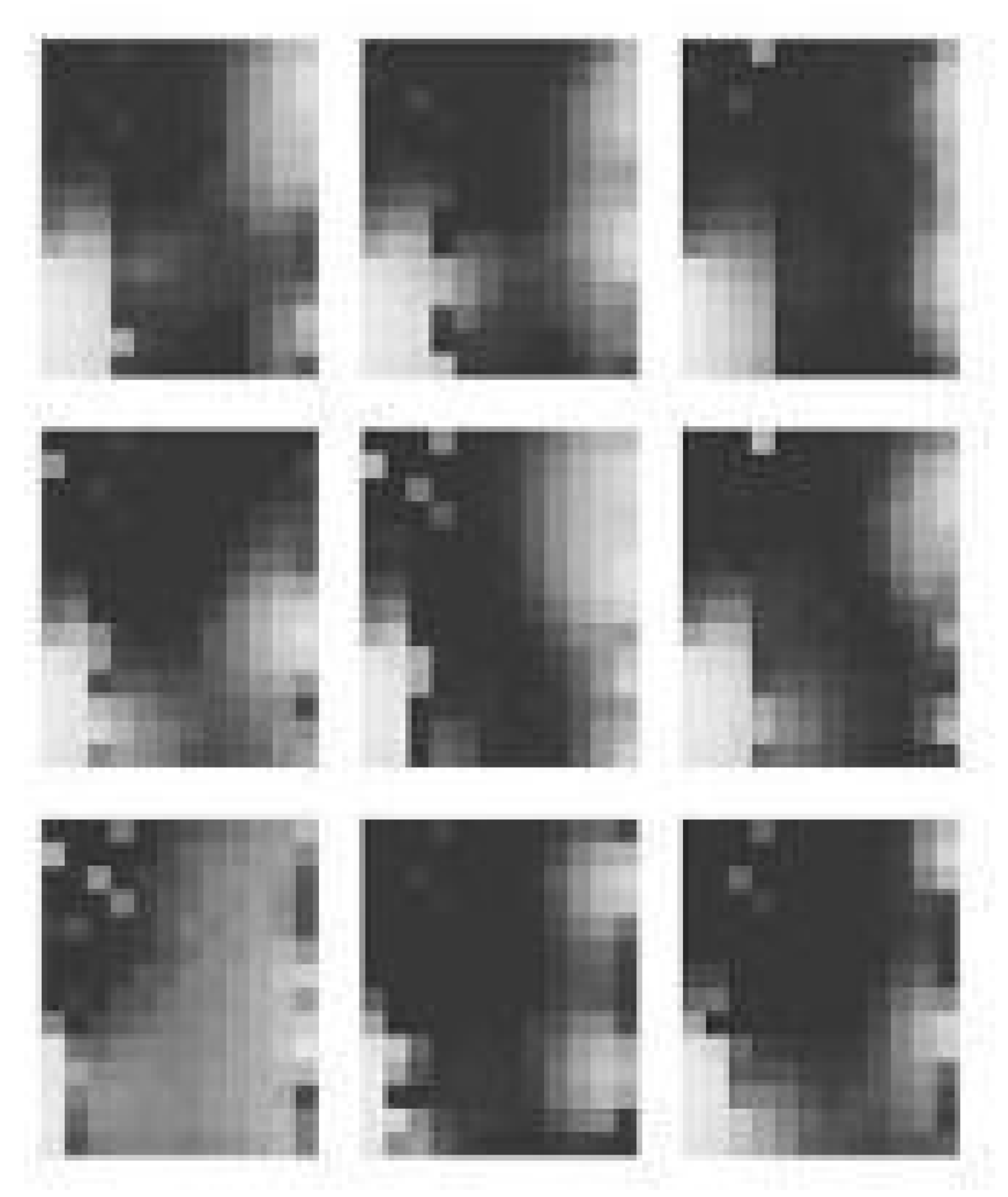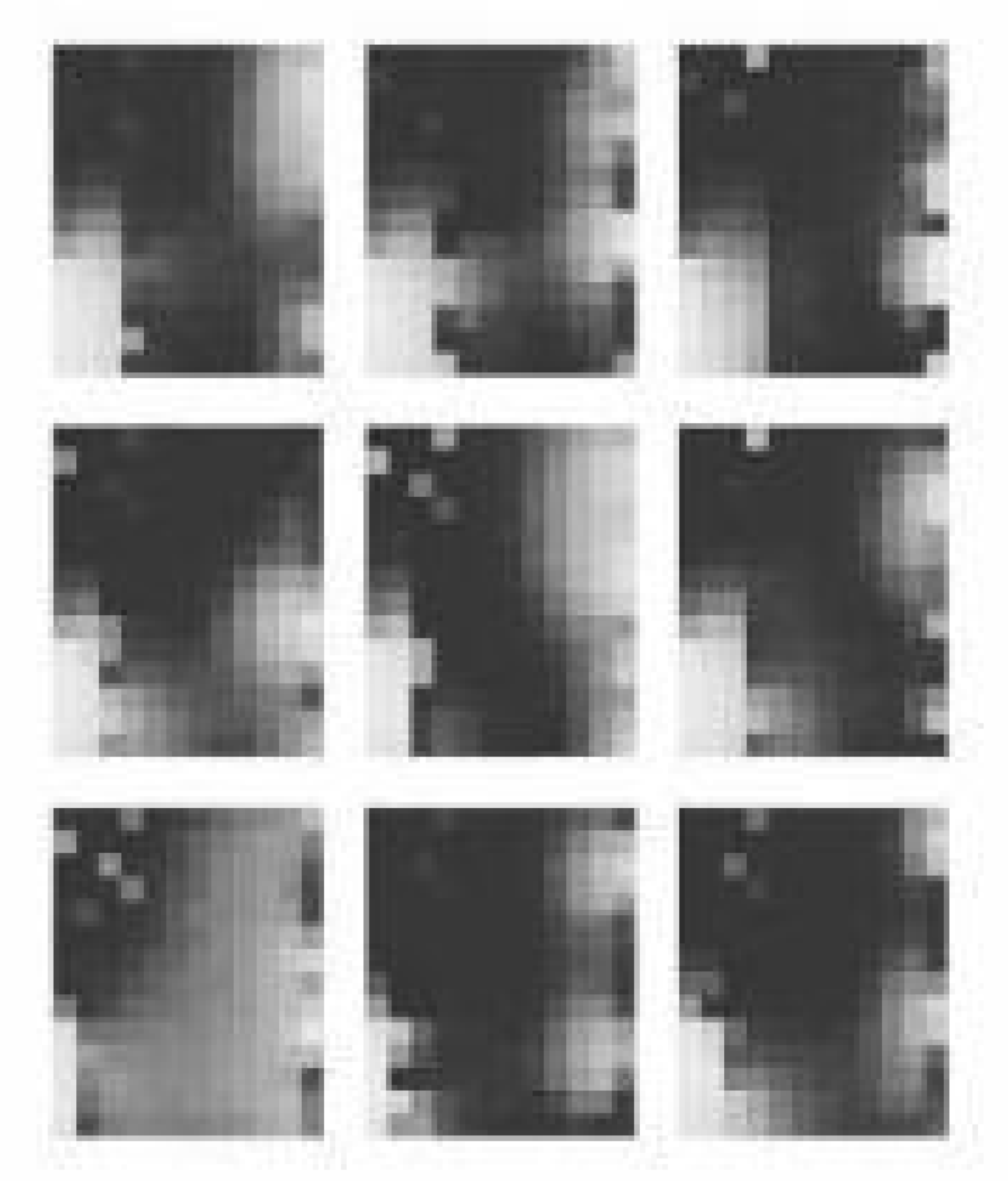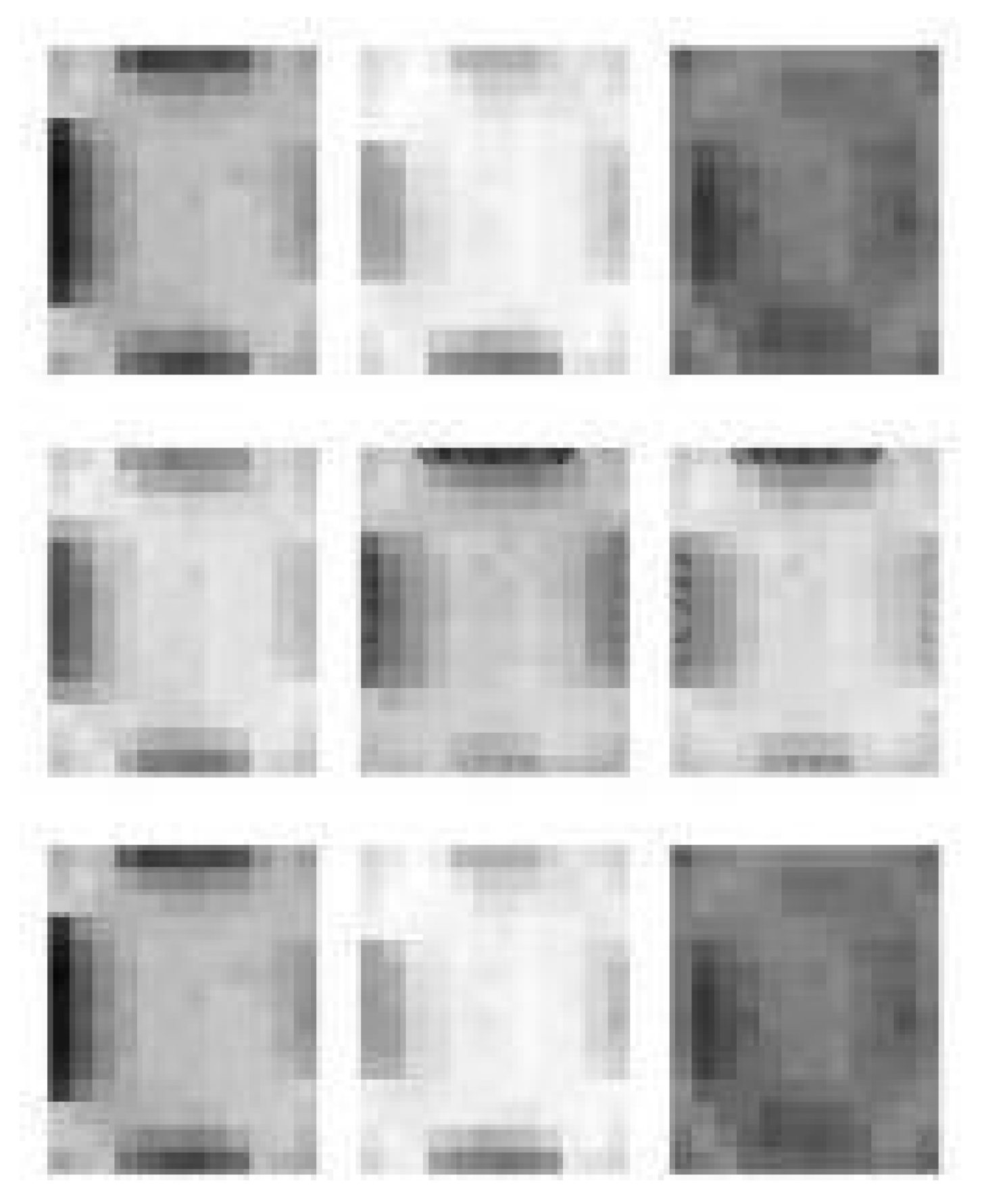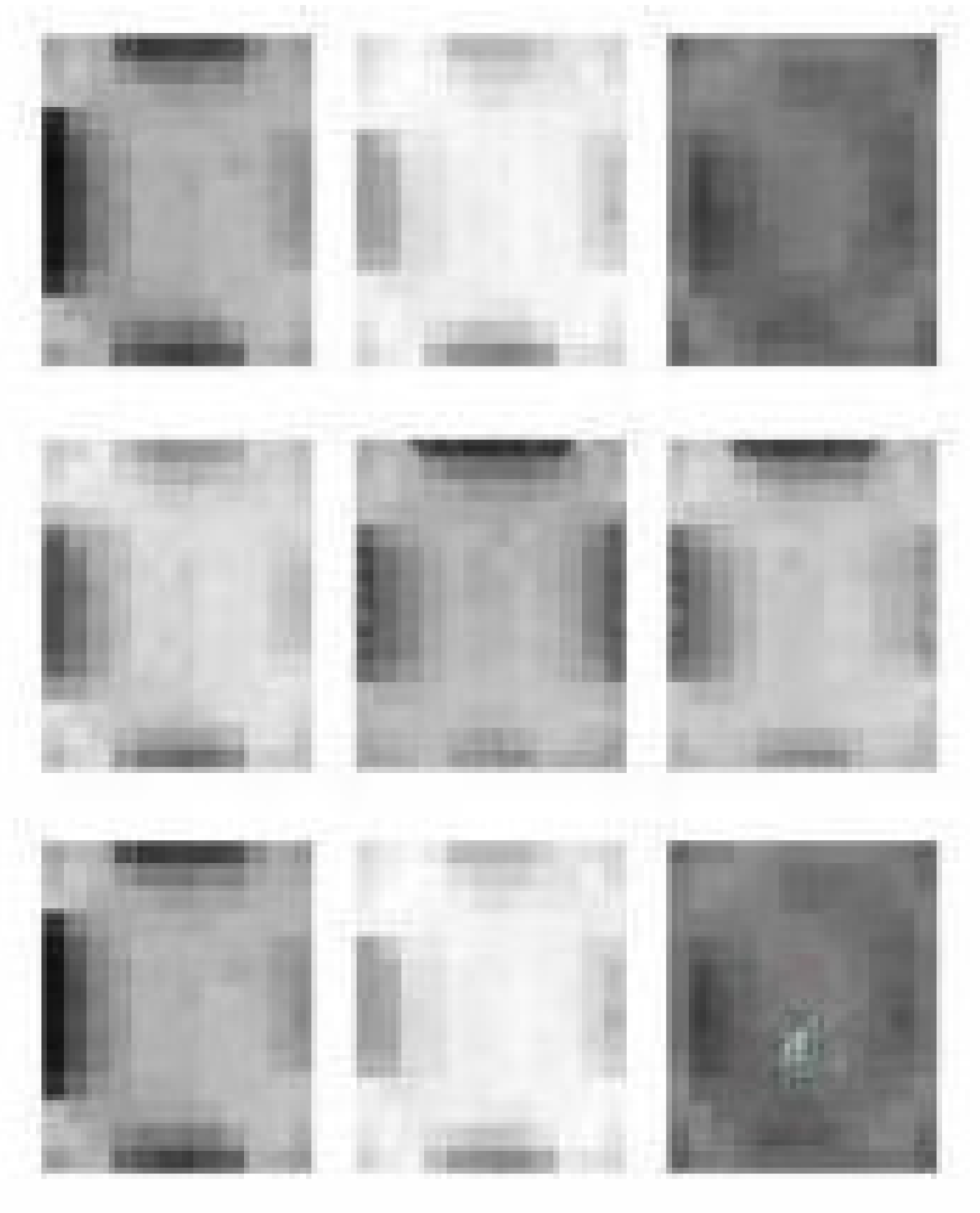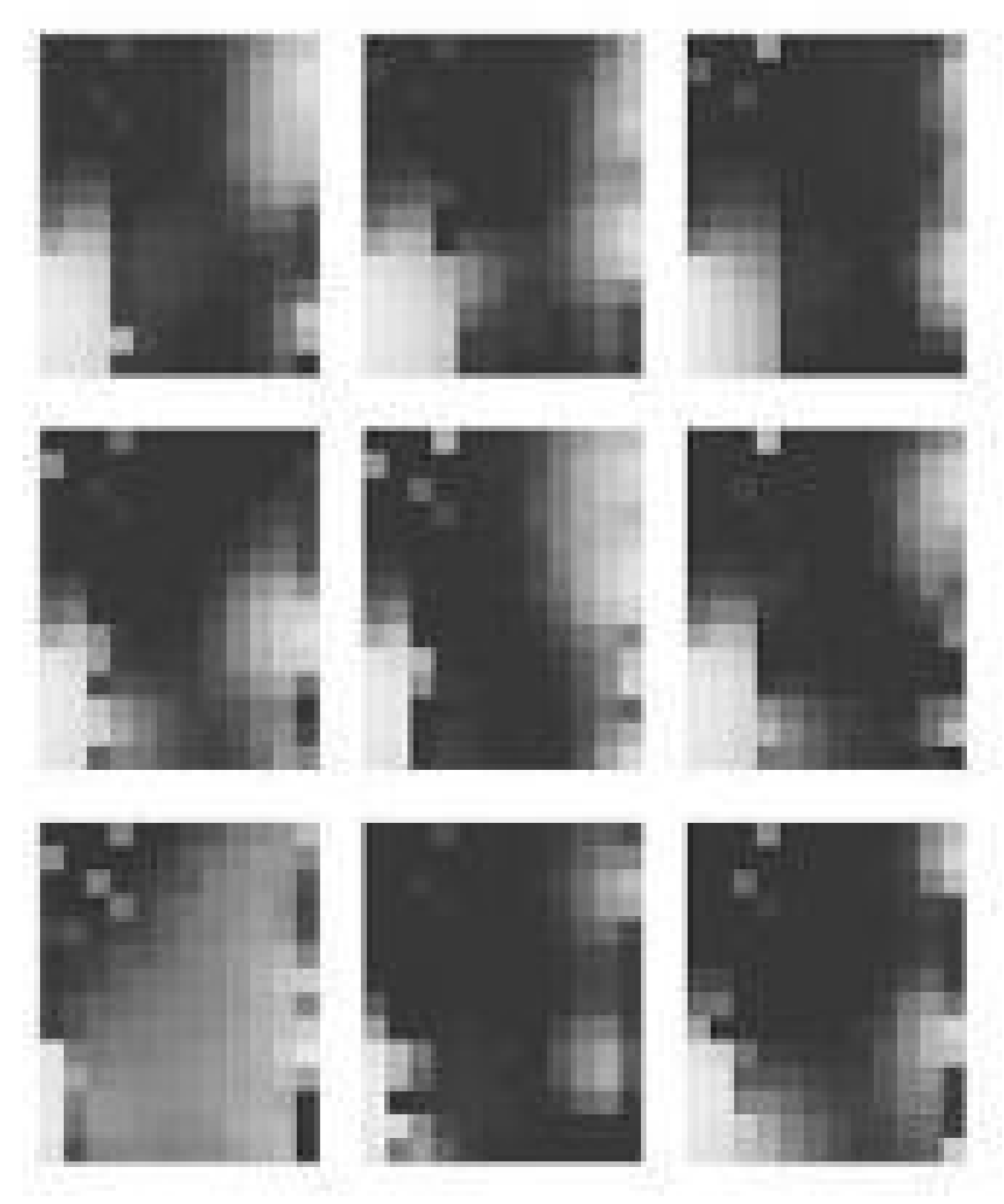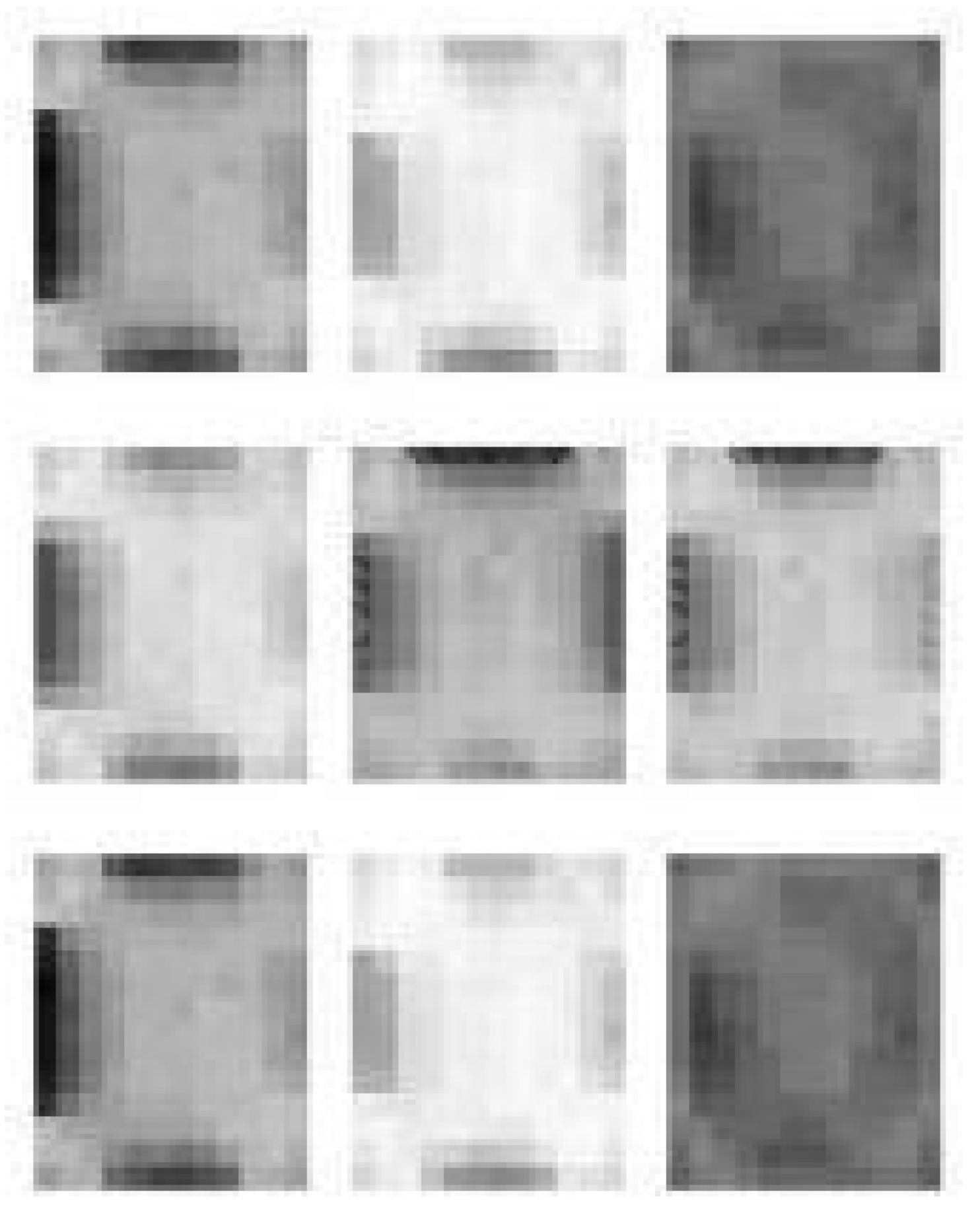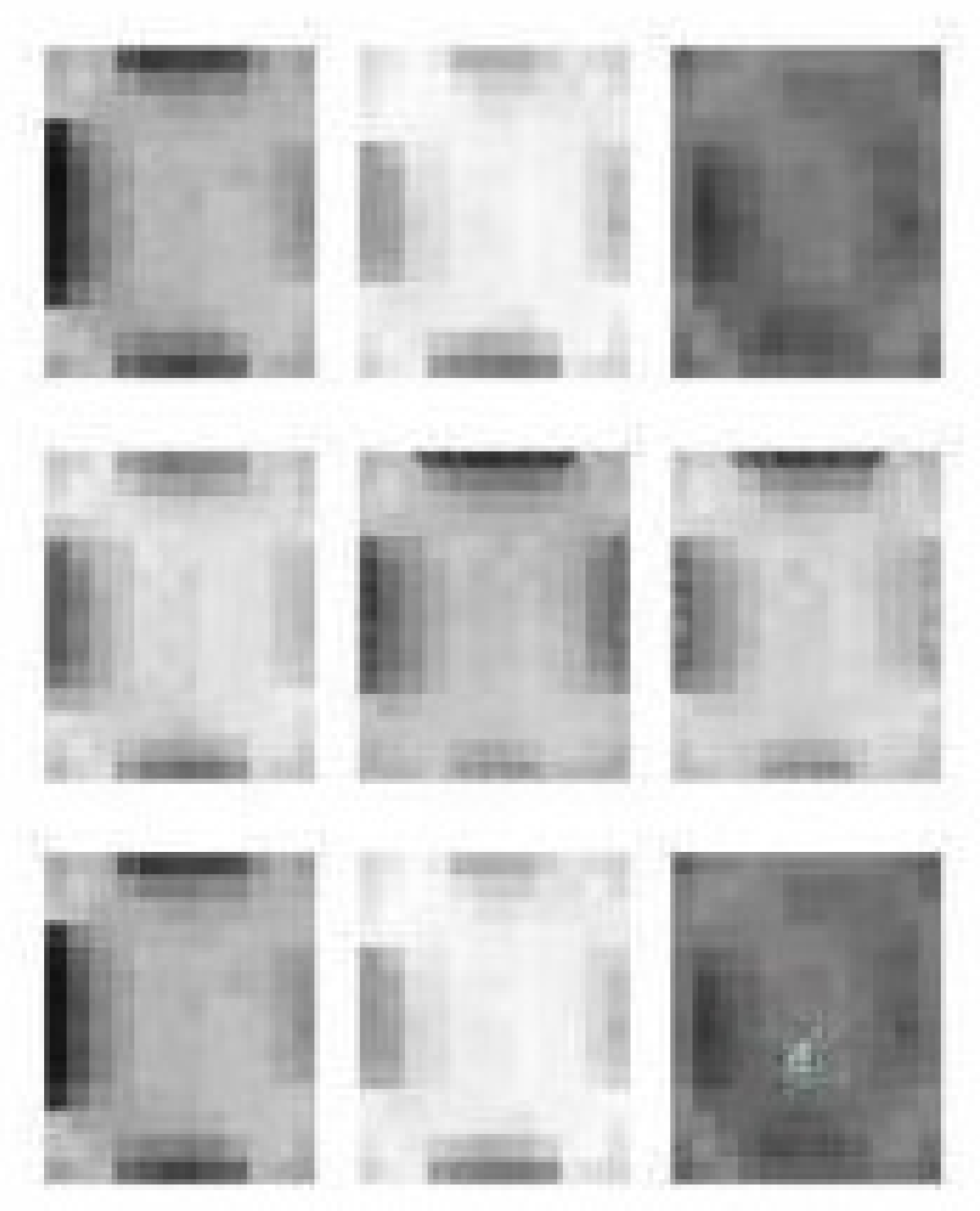Abstract
Reducing energy consumption while providing a high-quality environment for building occupants has become an important target worthy of consideration in the pre-design stage. A reasonable design can achieve both better performance and energy conservation. Parametric design tools show potential to integrate performance simulation and control elements into the early design stage. The large number of design scheme iterations, however, increases the computational load and simulation time, hampering the search for optimized solutions. This paper proposes an integration of parametric design and optimization methods with performance simulation, machine learning, and algorithmic generation. Architectural schemes were modeled parametrically, and numerous iterations were generated systematically and imported into neural networks. Generative Adversarial Networks (GANs) were used to predict environmental performance based on the simulation results. Then, multi-object optimization can be achieved through the fast evolution of the genetic algorithm binding with the database. The test case used in this paper demonstrates that this approach can solve the optimization problem with less time and computational cost, and it provides architects with a fast and easily implemented tool to optimize design strategies based on specific environmental objectives.
1. Introduction
1.1. Background
The construction industry and building operations significantly impact the environment, being responsible for 36% of final global energy consumption. Energy demand from buildings will continue to increase in the future [1]. Most of the energy consumed during building operation is for occupants’ comfort. Operational energy, used in artificial control of indoor environment quality—such as lighting, indoor air conditioning, and mechanical ventilation—constitutes around 80–90% of a building’s total energy use [2].
Optimization of building performance and energy consumption from the pre-design stage is especially important. Environmental performance simulation of buildings is based on local climate data, using a computer to establish a mathematical model to calculate performance information [3]. The simulated results can effectively show the indoor and outdoor environmental qualities of different aspects [4]. The design problems are complex and can be expressed as a multi-objective optimization problem which takes into account all the selected performance objectives which may contradict each other. Multi-objective optimization is particularly important because it addresses the multiple objectives together at one time. It can provide designers with a set of optimal solutions, all within the trade-off ranges between two or more conflicting objectives [5]. Thermal comfort and visual comfort are the two common conflicting objectives when balancing the overall building performance, and these conflicts must be resolved to reach multi-objective optimization. This paper uses an innovation methodology to find a practical and repetitive way to achieve multi-objective optimization with the combination of building performance simulation and Artificial Intelligence.
1.2. Problem Statement and Objectives
For common building performance tests, the results of different aspects, e.g., light, energy, and airflow pattern, are simulated in different software for each test scenario, which consumes a lot of time [6]. Moreover, the simulation only shows the test results without offering guidance for optimization, necessitating more tests for the optimization itself. Big datasets are needed for GA programs to achieve accurate optimization results. Therefore, it is necessary to improve simulation efficiency and to optimize the methodology for solving these problems.
This paper proposes a comprehensive and integrated method for systematic multi-objective optimization of building performance using machine learning to improve the efficiency of environmental assessment based on parametric design and combining genetic algorithms to optimize the performance of parameterized buildings (Figure 1). Many previous studies limited their scope to only one or two optimization goals. Compared to them, this methodology can account for different optimization goals for architectural proposals and customize performance optimization goals, while ensuring accuracy and efficiency.
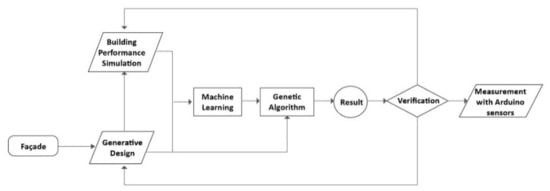
Figure 1.
Workflow of the methodology.
This paper details a new computational approach to optimizing multiple environmental performances on a building scale and even on an urban scale with high versatility, convenience, and efficiency for architects and urban planners (Figure 1). The case chosen for this paper concerns the impact of building façades on indoor environmental quality because the building façade forms a barrier between the exterior and interior environments and has a crucial role in energy efficiency and building performance. Glass on the façade allows the ingress of natural light and solar radiation, visually and thermally impacting the interior environment. Natural lighting and heat are important to the physical and mental health of occupants, but the solar irradiation of natural light for visual comfort may also bring excess heat to the interior, especially during a hot summer. Therefore, this case optimized the visual and thermal comfort by using AI to control external façade pattern parameters to balance the natural light and heat coming indoors. Through the case study presented in this paper, we show how this new computational approach can be used to explore hundreds of possible solutions provided by parametric design to achieve the final optimized building performance solutions and how to prove its efficiency and accuracy.
1.3. Literature Review
The literature informing this study is divided into two main types based on the research process: design process research and AI (Artificial Intelligence) methods. The design process begins with parametric design, which can provide integral control in the pre-design stage, affecting the building performance and therefore laying the foundation of the whole experiment [3]. Then, different building performance simulations are obtained following the change of parametric factors. Then, optimization is achieved based on the results of simulation results to meet the optimization target.
Secondly, for the AI process, machine learning is added as the process for improving the efficiency of the simulation. Different types of machine learning methods are discussed to meet different case situations. Then, a genetic algorithm is used for optimization to achieve one or several targets, and the different algorithm logic is discussed.
1.3.1. Design Process
During the design process, form generation is controlled by the modeling parameters. Generative design uses a bottom-up paradigm and parameter control to achieve the design target or solve design problems efficiently [7]. One of the main advantages of parametric models is that they can be easily transformed, resulting in variations of different configurations with the same geometric elements [8]. Design of different scales, from building components such as the façade, building massing, and urban-scale clusters, can be achieved through parametric tools (Figure 2). The overall model can be conceptualized as a group of typical finite instances, each instance determined by the specific values of the model-independent variables, increasing control over building representation management. A large number of instances can be filtered based on the results of environmental performance simulation, and the survivors can then be subjected to optimization, thus providing convenient integration of building performance simulation into the architectural design stage.
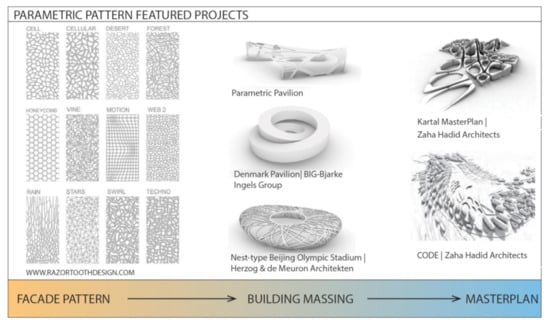
Figure 2.
Parametric pattern featured projects.
In the early stages of building design, parametric design technology plays an important role in creating design scenario datasets for the simulation [9]. Environmental performance is an important factor in designers’ decision making and can be evaluated through building performance simulations and environmental assessment databases [6]. Yun Kyu Yi created a parametric model of building façades and generated many deformations of façade patterns for evaluating the environmental performance of the building façade [10]. Bakmohammadi and Noorzai developed a parametric model using Ladybug and Honeybee, which are plug-ins for the Grasshopper–Rhino 3D modeling platform, to evaluate energy performance and thermal comfort and found optimized solutions [11]. In another case, the parameters of construction materials and shading devices which lead to the best performance in daylighting and energy performance were selected after iterative simulations of a five-story residential building in Egypt [12]. Parametric design tools can also be used for biomimetic optimization of building performance: Abdel-Rahman explored the possibility of reducing building envelope thermal loads using parametric biomimetic design [13].
Optimization is the next stage after simulation. Optimization is the final problem solution step of architectural design, usually based on the simulation results. The simplest optimization is usually completed by adjusting parameters and models manually, solving one target at a time. Multi-objective optimization is difficult to implement when working manually because it involves balancing contradictory objectives. The main way to integrate such optimization with parametric design in Rhino is by using Python plug-ins such as Octopus, Galapagos, and Wallacei [14]. Fathy and Fareed used Octopus on the daylighting and energy performance of a building façade to balance sufficient daylighting against energy savings in the design stage [13]. Another multi-objective optimization method is to evaluate performance via non-linear programming, for example using NSGA-II (Non-dominated Sorting Genetic Algorithm II). Kim and Clayton set the minimum cooling load and maximum daylighting performance as two conflicting optimization targets on climate-adaptive building envelopes during summer in a hot, humid climate [15]. The last way is to program a new optimization system customized to the specific project. Luan et al. proposed a novel automatic simulation optimization procedure for an origami-style shading device based on dynamic sunlight via DIVA (Data-Interpolating Variational Analysis) and an optimization method called BCMO (Balancing Composite Motion Optimization), aiming to improve daylighting performance while concurrently reducing the building’s energy consumption [16].
1.3.2. Artificial Intelligence Processes
Artificial Intelligence can improve processing efficiency when solving target problems. The main methods used are ANNs (Artificial Neural Networks) and GAs (Genetic Algorithms) for performance prediction and objective optimization, respectively. The following review will introduce different applications in these two fields.
ANN models can be trained to detect patterns inside the environmental analytical data and thus perform predictions early in the design process. CNN (Convolutional Neural Network) and GAN (Generative Adversarial Network) are two main ANN models applied in building performance processing. A CNN realizes feature extraction of input data by superposing a convolutional layer and a pooling layer and finally realizes classification through a fully-connected layer. GAN comprises a generative network and a discriminant network, which are used together to learn classification image features [17].
For image processing, a CNN is mainly applied in image classification, target detection, target recognition, and segmentation. Kim et al. used a CNN to detect and extract the interior elements, including furniture, in images and to classify the furniture design style automatically [18]. Even Chen et al. were challenged to recognize the architectural functionality and style in different architectural images [19]. While a CNN can detect and recognize information only from existing images, both image learning and generation can be conducted by using a GAN.
GAN is widely used in image learning and prediction, with applications in image synthesis, image editing, style transfer, image super-resolution, image transformation, data enhancement, etc. [19]. Some studies use image-based inputs to train machine learning models for floor plan generation [20] and urban environmental analysis [21]. Given a small number of reliable simulation results, machine learning methods such as GAN can efficiently predict building performance results for many further scenarios and improve accuracy. Environmental indicators can be predicted by machine learning models with the aid of parametric modeling in the early design phase. Sebestyen and Tyc used machine learning to predict the sunlight hours and irradiance received by the building façade and tested the result’s precision [22]. To improve the efficiency of pedestrian wind flow learned from computational fluid dynamics simulation results, community datasets were provided for a GAN to predict wind flow across buildings in different layouts [23]. Urban spatial morphologies could be learned by a GAN for application to microclimate performance simulation. For example, Venice has been studied for a diverse set of fitness objectives under an urban network [21].
Many optimization methods have been developed recently, most of which are inspired by nature [24], being heuristic (or meta-heuristic) methods that imitate natural strategies. Therefore, they offer some advantages over previous methods for complex optimization problems. Among the evolutionary computation technologies, GAs (Genetic Algorithms) aim to discover the design solution with the best performance. They involve the iterative process of a population of potential solutions subject to growth, reproduction, selection, and survival and inherently consider multiple solutions in each iteration. The population converges to the optimal solution through natural selection over many generations. Multiple offspring in the group can act as independent individuals, and the group can explore the search space in multiple directions at the same time to avoid falling into a local optimum.
NSGA-II, mentioned above, is one of the most popular multi-objective genetic algorithms. It reduces the complexity of the non-inferior sorting genetic algorithm, having the advantages of fast running speed and good convergence of the solution set and has become the performance benchmark of multi-objective optimization algorithms. Using the Pareto front to minimize energy use is one of the main concerns in multi-objective optimization with GA. Hamdy et al. used NSGA-II to find a strategy for energy conservation measures and to improve building thermal performance in a nearly zero energy building [25]. New residential building models in hot summer and cold winter areas of China were designed to improve indoor thermal comfort and reduce building energy consumption with NSGA-II [26]. MathWorks combined its MATLAB EnergyPlus building energy simulation engine and the Pareto front into an improved NSGA-II algorithm. By applying this new algorithm to a set of building skin and window parameters, Tuhus-Dubrow and Krarti improved the envelope to minimize energy use for residential buildings [27]. Ascione et al. lowered building energy consumption by using a GA and intelligent sampling to optimize the design variables of building geometry, envelope, and energy system, achieving the most sustainable, cost-optimal, and low-investment design in each stage [28].
With Pareto front solutions playing the main role in GA optimization, versatility and convenience were improved with other software. Octopus and Galapagos are plug-ins into the Rhino parametric design platform, providing access to evolutionary algorithms for designers. Jalali, Noorzai, and Heidari used Grasshopper to control the parameters of the building envelope, interior space, and building geometry to improve the relationship between building space and energy loading based on the solar radiation optimization in Octopus [29]. Zhou used Octopus to improve the interior lighting situation by shading devices for educational building façades in Paris [30]. Ilbeigi et al. lowered energy consumption around 35% using Galapagos to optimize the U-value of wall insulation [31]. With the help of Octopus and Galapagos, more potential will be developed when GA is combined with parametric design in Rhino.
2. Methodology
The entire workflow (Figure 3) is divided into four main stages: parametric modeling, performance simulation, artificial intelligence, and validation. The main challenge is to increase the speed of the simulation phase and to provide the simulation results as instantaneous feedback for parametric modeling in the early design stage.

Figure 3.
Optimization and validation workflow.
There are four significant steps in this workflow. First, the parametric modeling process is set up in Grasshopper, a component of the 3D modeling platform Rhino, to parameterize the specific building elements for iterative generation. Second, the building performance simulations are conducted with Grasshopper plug-ins Ladybug and Honeybee to evaluate different types of building performance. In the third stage, the artificial neural network model will be set up. Original building patterns are used as inputs and simulation results as target outputs to train the Pix2Pix GAN. Pix2Pix GAN is the conditional adversarial network working for solving the problems of image-to-image translation [32]. Then, the trained GAN replaces the simulation engines to predict results. Supervisor learning is used via Python scripts to monitor the generation of new building patterns and to transfer them to the machine learning model to obtain the predicted results, which helps map the inputs to the outputs based on example input–output pairs [33]. In contrast to the time-consuming simulations, the GAN can supply highly accurate performance predictions in real time [34]. As shown in Figure 3, the genetic algorithm in the last part is used for optimization. Multi-objective optimization is undertaken in this study, aimed at balancing the potential conflict factors and to achieve overall better performance. Finally, the validation will be carried out by comparing the simulation results and measurement data from the real environmental Arduino sensors.
2.1. The Case Study
The case study building for the experiment is a façade model based on Mikimoto Ginza 2 (Figure 4) in Japan, which was designed by Pritzker-Prize-awarded architect Toyo Ito. The case building model has a basic box shape, with the dimension of each floor plan being 17 m × 16 m (Figure 5). All floors are column-free so that daylighting can cover the floor plan [35]. This Voronoi pattern on the façade is the deformation factor for optimization in the generative stage. The glazing of this building directly affects indoor light and the thermal environment. For these reasons, the façade of this building has been chosen as an illustrative case to explore façade design solutions for building performance optimization concerning daylighting and thermal performance.
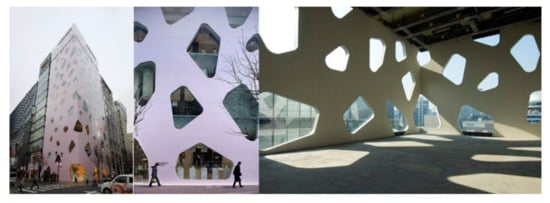
Figure 4.
Mikimoto Ginza 2.
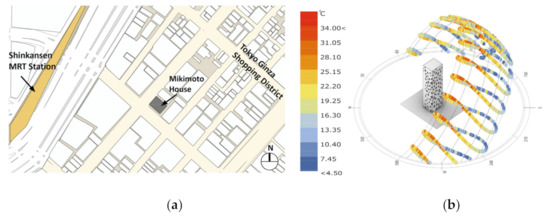
Figure 5.
Mikimoto Ginza 2 location (a) and sun path visualization showing the relative dry bulb temperature (b).
For this study, the climatic conditions need to be examined first. Tokyo is in the humid subtropical world climate zone, characterized by fairly mild winters and hot, humid, rainy summers [36]. Tokyo dry-bulb temperature peaks around 31 °C, and the coldest temperature in winter is around 1 °C (Figure 6a), necessitating cooling from June to September, and heating from October to April (Figure 7). Global horizontal irradiance, especially direct normal irradiance, mostly comes from the south (Figure 6b). With enough daylighting and a comfortable indoor environment, mechanical intervention can be reduced, and energy can hence be saved. On average over the whole year, it is better to secure enough daylighting while reducing solar radiation into the interior environment, as solar heat influx conflicts with daylighting in some cases. It is therefore optimized for both daylighting and thermal comfort.
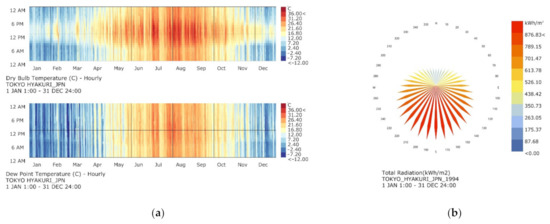
Figure 6.
Tokyo climate variables: (a) Tokyo dry bulb and dew point temperature; (b) Tokyo total radiation of whole year.

Figure 7.
Parametric modeling process of the Voronoi façade.
2.2. Parametric Modeling
To simulate the actual conditions of the case building and produce accurate optimization results, the current conditions of the Mikimoto Ginza House were researched. Only two walls with façades must be considered, as the other two walls are covered by adjacent buildings. The façade pattern is continuous as a folding rectangular surface with a Voronoi pattern; this pattern can be generated as a computational model with parametric design techniques using Grasshopper programming.
To build a façade model, the first step was to construct the same façade with the same height and width (Figure 7). Second, multiple points were populated in the region of the rectangle. The number of points was set as a parameter; it can also be understood as the number of openings. Third, modeling control extended from a point to the range of the Voronoi radius to generate planar Voronoi polygons for a collection of points. The Voronoi polygons were deformed into closed curves, and each shrank on a random scale ranging from 0.2 to 0.7. At this point, the parametric surface was the same as the case study façade. As two façades are blocked by the surroundings, only two surfaces have the Voronoi pattern. The building model was rotated at the same angle to match the actual orientation, with the main entrance facing southwest.
With the logic of the Voronoi pattern, the number, scale, and location of openings are direct variables and have a great impact on the indoor environment simulation for each floor. The WWR (window-to-wall ratio) index can be calculated for comparison.
2.3. Building Performance Simulation
2.3.1. Simulation Settings
Enhancing daylighting hours and improving thermal comfort were selected as two important objectives for optimization of the façade performance. Considering Tokyo’s local climate, less solar radiation and more daylighting are in conflict, especially in summer [37]. Daylight autonomy (DA) and thermal autonomy (TA) were used as metrics in daylight and thermal comfort simulations in Ladybug and Honeybee [38,39]. Ladybug and Honeybee are based on the Grasshopper platform, which integrates building performance simulation and visualization with parametric design, using engines such as Energy-Plus and Open Studio for energy simulation [40] and Radiance and Daysim for daylighting analysis [41,42]. Table 1 shows the parameter settings.

Table 1.
Simulation parameters settings.
In the simulation process, 100 sample training pairs were generated from the parametric model, which includes façade pattern, DA, and TA. For the simulation grid setting, each simulation surface was 0.8 m above the floor [43]. There were 272 measuring meshes on one surface, with a grid size of 1 m × 1 m. In the center of each grid mesh, there was one measuring point to obtain the simulation result, a total of 272 points on one floor. The DA and TA were simulated for each floor; the total simulation visualization of nine floors was arranged into one image for preparation of the training datasets for the machine learning model (Figure 8).
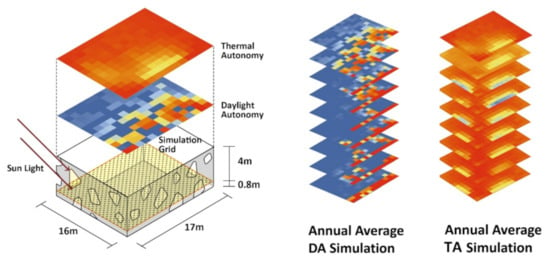
Figure 8.
Simulation setting showing the façade, test points, sun rays, TA, and DA visualization.
2.3.2. Daylight Simulation
DA simulation was performed simultaneously for nine floors. DA is the percentage of occupied time over annual daytime hours in which natural daylighting meets the minimum illumination range of the space, defined by Equation (1) [37,44]. The DA threshold was set as 300 lux to achieve the minimum generic office occupancy light needs in this case. The simulated DA of each measuring point represents the percentage of a year that the illuminance exceeds 300 lux, which is the minimum threshold of illuminance [45]. The sum of DA values was calculated to compare the overall daylight performance of each scheme. A higher total value indicates better daylight performance.
where is occupied hours; is the number of time steps; is the available daylight level; is the illuminance threshold; and is the weighting factor, dependent on the illuminance threshold.
The original case pattern was simulated first to evaluate the current DA performance (Figure 9). The DA of each floor is different due to different dimensions and positions of the openings on each floor. Each point represents the average DA value of nine floors with a specific WWR, as shown in Figure 10. There is an overall relationship between DA and WWR; when an opening and the WWR are larger, the DA tends to increase.
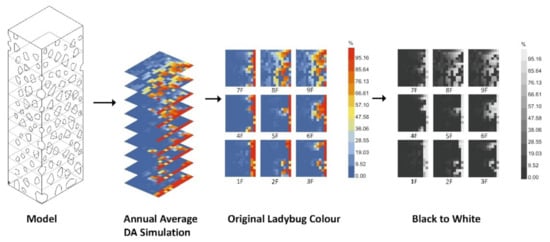
Figure 9.
Daylight simulation showing daylight autonomy results.
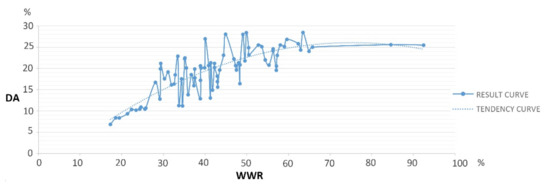
Figure 10.
Relationship between DA (y-axis) and WWR (x-axis).
2.3.3. Thermal Comfort Simulation
TA evaluates the thermal comfort conditions of occupants on each floor, defined as the percent of occupied time where a point in space meets or exceeds a given set of thermal comfort acceptability criteria through passive means only [37,46]. Occupancy thresholds between 0 and 1 were assigned to all zones on different floors based on the default occupancy schedule of commercial buildings in Honeybee [38], with an analysis period from 8 am to 6 pm on weekdays [47]. As the free-running mode is assumed, the adaptive thermal comfort model was used, as shown in Equation (2) [37].
where represents the prevailing mean outdoor air temperature, and represents the indoor operative temperature.
Of the design variables considered in this study, the WWR and the position of the openings on the façade have a great impact on TA. A higher TA indicates that occupants are comfortable longer in a space without mechanical heating or cooling systems, resulting in lower heating or cooling demand to improve thermal performance. As with DA, the original façade pattern of the case building was simulated to evaluate the TA performance (Figure 11). The simulated TA at each sensor point was calculated and summed to represent the overall conditions of the space on each floor. On each floor, the areas near the openings on the west and north façades exhibited lower average TA than other areas over an entire year. A higher total indicates better thermal comfort conditions.
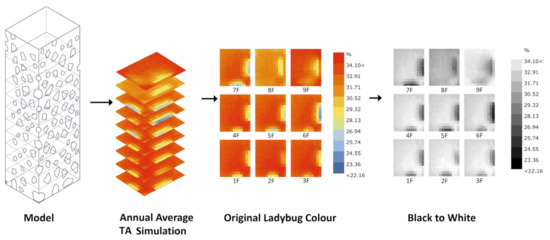
Figure 11.
Thermal comfort simulation showing thermal autonomy results.
There is a clear decreasing trend of TA as WWR increases, as shown in Figure 12. For this case, large openings on the façade generally indicate more shortwave radiation entering and possibly greater cooling demand in summer, and heat loss to the outdoors resulting in greater heating demand in winter. Thus, a lower WWR on the façade is beneficial for increasing thermal comfort; DA and TA have different demands for WWR.
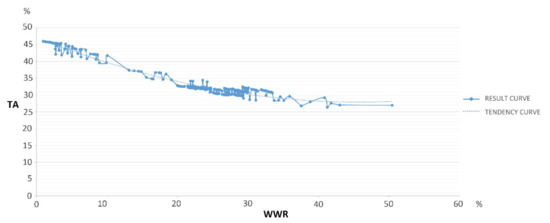
Figure 12.
Relationship between TA (y-axis) and WWR (x-axis).
2.4. Machine Learning
2.4.1. The Training and Validation of the Machine Learning Model
In the machine learning process, pix2pixHD was selected as a tool to learn the mapping from training input images (unfolded façade images) and output images (DA and TA simulation visualizations) (Figure 13). Using dedicated building performance simulation software is time-consuming and computationally expensive in the traditional simulation process. However, a workflow empowered by machine learning can quickly estimate building performance from images of the building façade once the model has been adequately trained by the training sets. The machine learning network and checkpoint results were connected to the Grasshopper platform to generate the predicted simulation results. The predicted results were produced in 5 s after Grasshopper used its automation parameter programming to generate the new pattern.
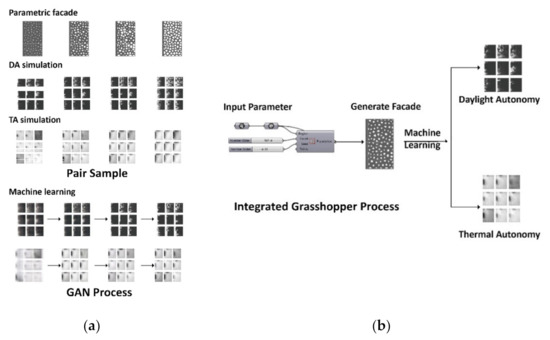
Figure 13.
GAN and Grasshopper process: (a) dataset preparation for training the machine learning model; (b) output of machine learning model.
The machine learning model used in this experiment is an extension of the Generative Adversarial Network (GAN) model, which consists of two competing networks: a generator that maps a sample to the desired distribution and a discriminator that determines if a generated false image belongs to this distribution (Figure 14) [32]. The DA and TA visualizations are converted to black and white to make the pattern rules clearer, so the GAN can more easily learn and generate new outputs.
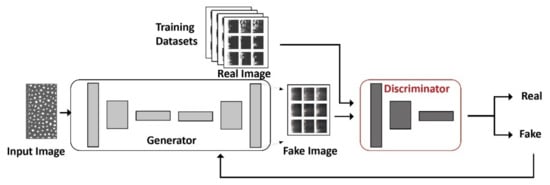
Figure 14.
The implementation of a generative adversarial network (GAN) deep learning model.
Validation of model accuracy was performed by comparing all predicted DA graphics and TA visualizations to the simulation results. After converting the visualizations to grayscale images, the RGB values of each pixel were compared. The mean absolute error (MAE) was used to test the accuracy of the machine learning prediction by comparing the absolute difference between the simulation results and predicted results (Equation (3)) [48]. The calculation results indicate that the accuracy of machine learning prediction can reach 99% (Table 2).
where is the RGB of pixel in the predicted visualization, and is the RGB of pixel in the simulated visualization. The total number of pixels in both visualizations is .

Table 2.
Accuracy of the machine learning model based on MAE.
The entire simulation was performed on an ordinary Windows laptop with core i7 8th Gen, and the time cost in the building performance simulation process when applying machine learning was greatly reduced compared to a traditional simulation. Normal DA and TA simulation required 30 min per scheme; machine learning required only 5 s, with approximately 99% accuracy. Preparing the dataset of simulation results to train the model required 100 h; another 3 h were required to train the machine learning model (Table 3). The new predicted results were generated in approximately 5 s after providing the new pattern. The new methodology required a total of approximately 105 h, whereas 1500 h would be required using a traditional simulation. The efficiency of the entire process increased by a factor of ten. With more datasets, the efficiency of this methodology can be increased.

Table 3.
Comparison of the efficiency of machine learning and simulation.
2.4.2. Mapping Grayscale Values
In the visualizations of DA and TA, the simulated result for each sensor point was between 0% and 100%, and was converted to a grayscale value between black and white (0 to 255). Lighter pixels indicate higher grayscale values. The graphic results of the machine learning model show the predicted DA and TA in grayscale values, which can be converted back to a percentage. For instance, a grayscale value of 150 at one sensor point in the DA map corresponds to a DA value of 58.82%. Lower grayscale values in DA and TA maps indicate better performance.
2.5. Optimization Using a Genetic Algorithm
To perform multi-objective optimization, the genetic algorithm was implemented using Galapagos in Rhino. Galapagos is an evolutionary solver with an embedded genetic algorithm framework; it is one of the most commonly used optimization tools in parametric design [49]. Galapagos uses feedback loops in the initial stage to reconsider the design variables. In each consecutive analysis, the algorithm is trained by the results to find a better solution. Ultimately, the solution satisfies a final optimization objective, which is the appropriate way to obtain a better solution in this case (Figure 15).
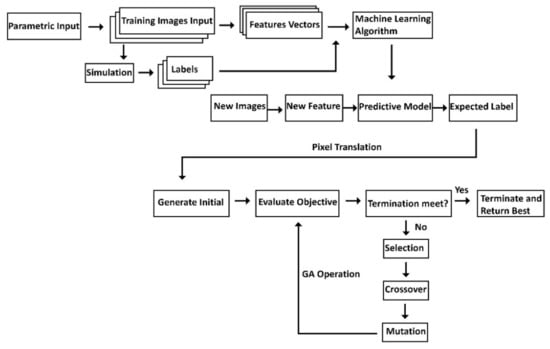
Figure 15.
Workflow of the genetic algorithm with a machine learning model as an evaluator.
Galapagos is a plug-in integrated into the Rhino system, which is easily connected to façade pattern parameters and machine learning codes. It is more suitable for morphology tasks. The visualization of the fitting process can help obtain the optimized result more efficiently.
In Grasshopper, the Galapagos component has two inputs [50]. One input is Genome, linked to the variables that control the façade parametric model, such as the number of openings. The other input is Fitness, linked to the performance score W generated from daylighting simulation results and thermal performance simulation results. W equals the product of the sum of grayscale values in DA and TA simulation. Seeking better daylighting and thermal performance (higher DA and TA), we combined them in the metric W and searched for its highest value, representing the optimal solution considering all objectives. In the experiment, Galapagos was set to search for the maximum Fitness value by changing the Genome input.
2.6. Validation with Measurements
2.6.1. Physical Model
The physical model test was conducted in Qingdao, China, which has almost the same latitude as Tokyo and similar sun exposure. Qingdao and Tokyo are both in humid subtropical regions in the world climate zone map (Figure 16) [51]. It is a transitional climate between subtropical and temperate zones [52]. It is hot and rainy in summer and cold and dry in winter, with four distinct seasons. The weather situations are almost the same, with only 1.5 °C difference in whole year average temperature and 5% difference in whole year solar radiation. The test was conducted at the end of July, when the two sites had similar weather conditions, especially in terms of sunlight direction and air temperature.
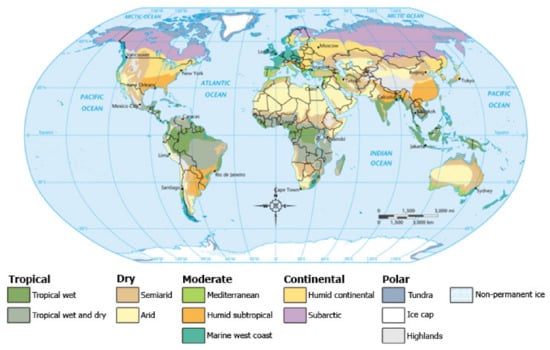
Figure 16.
World climate zone.
To verify the optimized design scheme, we built three physical models, original pattern, mid-optimized pattern, and final optimized pattern models, and compared them with an original physical model. The material was white PVC (polyvinyl chloride) boards; laser-cut technology was used to produce the physical models. The model scale was 1:100, with a height of 56 cm and a wall thickness of 3 mm. The three building models were arranged in a row with the same orientation as the case building in Tokyo, turning 45 degrees from the north to the west (Figure 17).
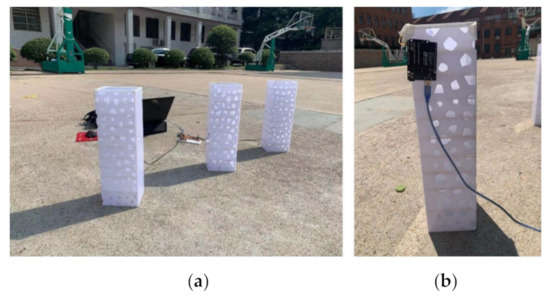
Figure 17.
(a,b) Physical models with sensors during the experiment.
2.6.2. Sensors
In the sensing system, Arduino was used to control multiple sensors by running codes. The entire system was programmed in C language; we prepared a specific code for each sensor to ensure its successful run. The Arduino processor connected the temperature sensor DS18B20 [53] and the light sensor BH1750 [54] in this study (Table 4) (Figure 18) and could be assembled in assembly language and manipulated for data analysis [55].

Table 4.
Equipment specification.
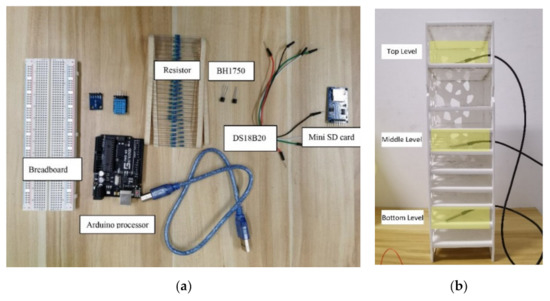
Figure 18.
(a,b): the hardware of Arduino and the sensors.
The three models were placed outside without any shade, allowing natural sunlight to reach the models. The light and temperature sensors were placed in the middle of the top, middle, and bottom levels (Figure 18b). Measurements were conducted for three days, in three sets from 9–10 am, 12–1 pm, and 3–4 pm, covering the majority of daytime occupancy.
3. Results
3.1. Optimization Result
A large number of parameters were sent to the system to generate different façade patterns, followed by the generation of predicted performance visualizations based on the trained machine learning model. As described in the methods section, all DA and TA visualizations were converted into grayscale images, and the performance score W was used as the evaluation metric for optimization. A higher W value represents more occupancy time with sufficient daylight and thermal comfort and less energy consumption for lighting, cooling, and heating demand. The GA system iteratively evaluated façade schemes with higher performance scores until it found the best solution.
With changes in the opening shape, size, and position of the windows on the façade, the WWR changed as well. The performance score tended to first increase and then decrease as the WWR increased, as shown in Figure 19. The tendency curve represents the overall trend of the change in performance score. The peak of the performance score was approximately 3.594 with a WWR of 15%. The best performance was achieved with a WWR of 10–20% in this study.
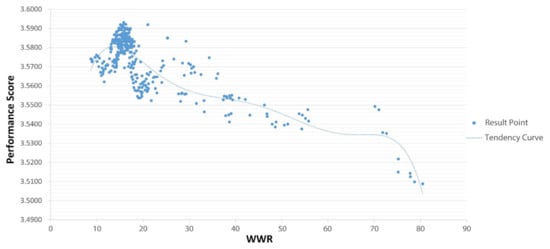
Figure 19.
Relationship between WWR and optimized scores-addition.
The visualization of the optimized scheme indicates higher grayscale values than the original scheme, as shown in Figure 20, indicating more indoor occupancy time with sufficient daylight and thermal comfort. Moreover, the color gradients of the DA and TA mappings became more uniform, representing more even daylight and thermal flux distributions. Generally, zones on different floors provide a more thermally and visually comfortable environment, preventing excessive solar radiation from entering.
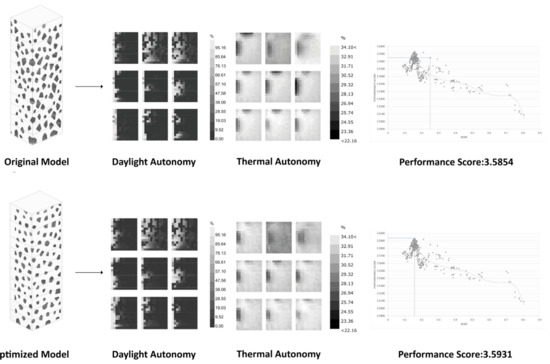
Figure 20.
Comparison of the original and the optimized results.
The annual comfort status was compared for the optimized scheme and the original scheme, as shown in Figure 21. The optimized model has more yellow areas (corresponding to comfort status) and fewer red areas (corresponding to hot status) than the original model, especially from October to April. Thus, the optimized façade system can reduce excess sunlight entering the interior, resulting in more comfortable space in the optimized result.

Figure 21.
Adaptive comfort comparison of the original and the optimized models.
From comparison of the original and optimized indoor adaptive comfort analyses, there was great improvement in comfortable time in the optimized model. In the simulation of one year, occupants in the original scenario experienced 4685 h of comfort, 848 h feeling hot, and 3227 h feeling cold. The optimized model improved the overall thermal comfort for the year, with 5565 h of comfort, 303 h feeling hot, and 2892 h feeling cold.
Energy consumption was determined to compare the year-round energy balance of different schemes (Figure 22). For the best-optimized scheme, there were fewer heating needs from November to April, and fewer cooling needs in summer. Generally, less energy is needed for light and thermal environment conditions. From the simulated energy data from different floors (Figure 23), the annual EUI (energy unit intensity) is lower than in the original scenario, especially for the ninth floor and the top floor. The optimized model reduces the average EUI from 115 to 65 KW/m2. Both the wall and the roof can receive heat radiated from the sun to the outer envelope and transfer the heat into the room, resulting in a large heat loss in winter and a heat gain in summer. The optimized model has fewer openings than the original design, avoiding too much heat transfer while ensuring sufficient daylighting.

Figure 22.
Energy balance comparison of the original (above) and the optimized (below) models.
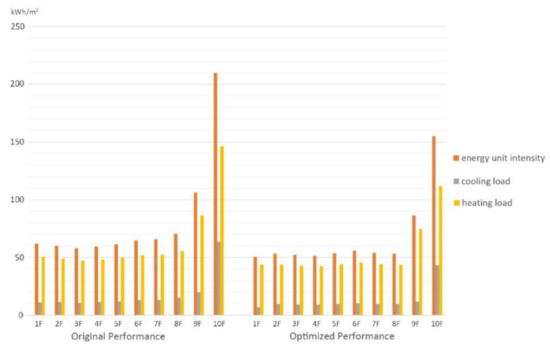
Figure 23.
Annual energy loading comparison of the original and the optimized models.
3.2. Physical Model Test Result
The diagrams (Figure 24 and Figure 25) show the measured illuminance and air temperature data on three floors for all three tested models. Illuminance was used to verify the DA optimization, and air temperature was used to evaluate the TA results. Measured air temperature is more stable than illuminance due to the rapid change of the direct sun angle and the actual global horizontal radiation conditions.
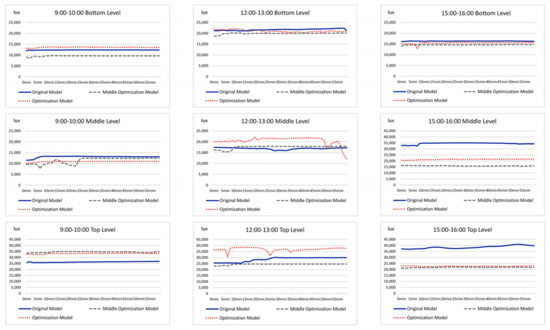
Figure 24.
The light intensity comparison of original, optimized, and best-optimized models.
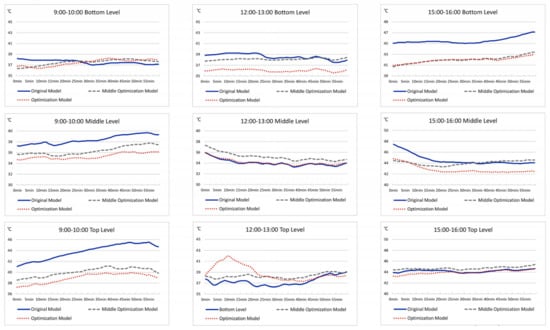
Figure 25.
The temperature comparison of original, optimized, and best-optimized models.
The original model received high light intensity, as shown in Figure 24. The two optimized models have higher illuminance than the original model when light is not sufficient in the morning, and lower illuminance when light is strong in the afternoon. Especially the optimized model has average 1000 lux higher than the original model in the morning, which improves the visual interior environment. The light environment is relatively stable in the two optimized models, avoiding strong exposure from the west side in the afternoon. The optimized model windows are generally smaller than those in the original model, which are almost one story high.
Figure 25 shows that the two optimized models have a lower temperature than the original model in summer, especially the model with the highest performance score. Although all measured data are higher than the common measured data of actual buildings due to the lack of insulation material in the openings in the physical models, the relative relationship indicated by comparing the three test models verifies the optimization.
Figure 26 shows a comprehensive comparison of the light and thermal environment performances of the three models. The best-optimized model has more stable illuminance, although the benefit of stability was not considered in the optimization. The results confirm that the optimized façade pattern can lower excess light exposure and radiation in the summer, improving the overall daylighting and thermal performance of the building. A comparison of the mid-optimized and final optimized models indicates performance improvements through the iterative process.

Figure 26.
The comprehensive comparison of original, optimized, and best-optimized models.
4. Conclusions and Discussion
This paper introduces a design framework for building environmental performance optimization on one integrated platform (Grasshopper), with a machine learning model and genetic algorithm embedded. The environmental simulation plug-ins are connected with a machine learning network (a GAN model) to generate the predicted performance results. These simulation results provide feedback to design solutions generated by the parametric model using a genetic algorithm for multi-objective optimization. In this case, the façade of Mikimoto Ginza House was optimized using this framework as an experiment; a physical model experiment was performed for validation.
The great potential of this design framework has been demonstrated. Compared to the computation time using simulation engines for all design iterations, the combination of simulation plug-ins and the machine learning model greatly reduced the time required in the simulation and optimization process. The accuracy of the machine-learning-model-based simulation was approximately 99%. The genetic algorithm can automatically generate an optimal façade solution once the fitness objective is defined. The physical model test validated the optimization results.
There are some limitations in this case experiment. The accuracy of the machine learning model is related to the similarity of the image-based simulation results and the façade pattern. Due to the limitations of the simulation software, the building thermal performance is less sensitive to a change in façade patterns than daylight performance. In this experiment, only annual daylight and thermal comfort performances were simulated and optimized. For further improvement, daylight and thermal performance at a specific time of the year could be considered, as well as additional building performance objectives.
Author Contributions
Conceptualization, H.Z. and M.H.; methodology, M.H. and H.Z.; resources: Y.L. (Yijun Lu) and W.W.; software, Y.L. (Yijun Lu) and W.W.; validation, X.G. and Y.L. (Yijun Lu); investigation, X.G.; data curation, Y.L. (Yijun Lu) and X.G.; formal analysis: Y.L. (Yijun Lu) and W.W.; writing—original draft preparation, Y.L. (Yijun Lu), W.W., X.G., Y.L. (Yanchen Liu) and M.H.; writing—review and editing, Y.L. (Yijun Lu), M.H. and H.Z.; visualization, Y.L. (Yijun Lu) and W.W.; supervision, M.H. and H.Z. All authors have read and agreed to the published version of the manuscript.
Funding
This research received no external funding.
Data Availability Statement
Not applicable.
Conflicts of Interest
The authors declare no conflict of interest.
References
- New Report: The Building and Construction Sector Can Reach Net Zero Carbon Emissions by 2050. Available online: https://www.worldgbc.org/news-media/WorldGBC-embodied-carbon-report-published (accessed on 14 September 2022).
- Yang, L.; Yan, H.; Lam, J.C. Thermal Comfort and Building Energy Consumption Implications—A Review. Appl. Energy 2014, 115, 164–173. [Google Scholar] [CrossRef]
- Aksamija, A. Methods for Integrating Parametric Design with Building Performance Analysis. In Proceedings of the EAAE/ARCC International Conference 2018, Philadelphia, PA, USA, 16–19 May 2018. [Google Scholar]
- Hien, W.N.; Poh, L.K.; Feriadi, H. The Use of Performance-Based Simulation Tools for Building Design and Evaluation—A Singapore Perspective. Build. Environ. 2000, 35, 709–736. [Google Scholar] [CrossRef]
- Fathy, F.; Fareed, H.A. Performance-driven Façade Design Using an Evolutionary Multi-Objective Optimization Approach. In Proceedings of the International Conference for Sustainable Design of the Built Environment-SDBE 2017, London, UK, 20–21 December 2017. [Google Scholar]
- Gagne, J.M.; Andersen, M. Multi-objective façade optimization for daylighting design using a genetic algorithm. In Proceedings of the SimBuild 2010-4th National Conference of IBPSA-USA 2010, New York, NY, USA, 11–13 August 2010. [Google Scholar]
- Mitchell, M.; Taylor, C.E. Evolutionary computation: An overview. Annu. Rev. Ecol. Syst. 1999, 30, 593–616. [Google Scholar] [CrossRef]
- Turrin, M.; von Buelow, P.; Stouffs, R. Design Explorations of Performance Driven Geometry in Architectural Design Using Parametric Modeling and Genetic Algorithms. Adv. Eng. Inform. 2011, 25, 656–675. [Google Scholar] [CrossRef]
- Gadelhak, M. Integrating Computational and Building Performance Simulation Techniques for Optimized Facade Designs. In Proceedings of the 31st International Conference on Education and Research in Computer Aided Architectural Design in Europe (eCAADe), Delft, The Netherlands, 18–20 September 2013; Volume 2. [Google Scholar]
- Yi, Y.K. Building Facade Multi-Objective Optimization for Daylight and Aesthetical Perception. Build. Environ. 2019, 156, 178–190. [Google Scholar] [CrossRef]
- Bakmohammadi, P.; Noorzai, E. Optimization of the Design of the Primary School Classrooms in Terms of Energy and Daylight Performance Considering Occupants’ Thermal and Visual Comfort. Energy Rep. 2020, 6, 1590–1607. [Google Scholar] [CrossRef]
- Toutou, A.; Fikry, M.; Mohamed, W. The Parametric Based Optimization Framework Daylighting and Energy Performance in Residential Buildings in Hot Arid Zone. Alex. Eng. J. 2018, 57, 3595–3608. [Google Scholar] [CrossRef]
- Abdel-Rahman, W.S. Thermal Performance Optimization of Parametric Building Envelope Based on Bio-Mimetic Inspiration. Ain Shams Eng. J. 2021, 12, 1133–1142. [Google Scholar] [CrossRef]
- Optimization Plug-In Categories & How to Download. Available online: http://wiki.bk.tudelft.nl/toi-pedia/Optimization_Plug-in_Categories_%26_How_to_download (accessed on 14 September 2022).
- Kim, H.; Clayton, M.J. A Multi-Objective Optimization Approach for Climate-Adaptive Building Envelope Design Using Parametric Behavior Maps. Build. Environ. 2020, 185, 107292. [Google Scholar] [CrossRef]
- Le-Thanh, L.; Le-Duc, T.; Ngo-Minh, H.; Nguyen, Q.-H.; Nguyen-Xuan, H. Optimal Design of an Origami-Inspired Kinetic Façade by Balancing Composite Motion Optimization for Improving Daylight Performance and Energy Efficiency. Energy 2021, 219, 119557. [Google Scholar] [CrossRef]
- Artificial Neural Network. Artificial Neural Network, Convolutional Neural Network, Recurrent neural Network, generative adversarial network, Artificial neural Network—Cloud community—Huawei Cloud. (n.d.). Available online: https://bbs.huaweicloud.com/blogs/259174 (accessed on 14 September 2022).
- Kim, J.S.; Song, J.Y.; Lee, J.K. Approach to the Extraction of Design Features of Interior Design Elements Using Image Recognition Technique. In Proceeding of CAADRIA 2018, Beijing, China, 17–19 May 2018. [Google Scholar]
- Chen, J.; Stouffs, R.; Biljecki, F. Hierarchical (Multi-Label) Architectural Image Recognition and Classification. In Proceedings of the CAADRIA 2021, Hong Kong, China, 29 March–1 April 2021. [Google Scholar]
- Huang, W.; Zheng, H. Architectural Drawings Recognition and Generation through Machine Learning. In Proceedings of the 38th Annual Conference of the Association for Computer Aided Design in Architecture (ACADIA) 2018, Mexico City, Mexico, 18–20 October 2018. [Google Scholar]
- Duering, S.; Chronic, A.; Koenig, R. Optimizing Urban Systems: Integrated optimization of spatial configurations. In Proceedings of the 11th Annual Symposium on Simulation for Architecture and Urban Design 2020, Vienna, Austria, 25–27 May 2020. [Google Scholar]
- Sebestyen, A.; Tyc, J. Machine Learning Methods in Energy Simulations for Architects and Designers—The Implementation of Supervised Machine Learning in the Context of the Computational Design Process. In Proceedings of the eCAADe 2020, Online, 16–17 September 2020. [Google Scholar]
- Mokhtar, S.; Sojka, A.; Davila, C.C. Conditional generative adversarial networks for pedestrian wind flow approximation. In Proceedings of the 11th Annual Symposium on Simulation for Architecture and Urban Design 2020, Vienna, Austria, 25–27 May 2020. [Google Scholar]
- Wahde, M. Biologically Inspired Optimization Methods: An Introduction; WIT Press: Southampton, UK, 2008. [Google Scholar]
- Hamdy, M.; Hasan, A.; Siren, K. A Multi-Stage Optimization Method for Cost-Optimal and Nearly-Zero-Energy Building Solutions in Line with the EPBD-Recast 2010. Energy Build. 2013, 56, 189–203. [Google Scholar] [CrossRef]
- Gou, S.; Nik, V.M.; Scartezzini, J.-L.; Zhao, Q.; Li, Z. Passive Design Optimization of Newly-Built Residential Buildings in Shanghai for Improving Indoor Thermal Comfort While Reducing Building Energy Demand. Energy Build. 2018, 169, 484–506. [Google Scholar] [CrossRef]
- Tuhus-Dubrow, D.; Krarti, M. Genetic-Algorithm Based Approach to Optimize Building Envelope Design for Residential Buildings. Build. Environ. 2010, 45, 1574–1581. [Google Scholar] [CrossRef]
- Ascione, F.; Bianco, N.; Mauro, G.M.; Vanoli, G.P. A New Comprehensive Framework for the Multi-Objective Optimization of Building Energy Design: Harlequin. Appl. Energy 2019, 241, 331–361. [Google Scholar] [CrossRef]
- Jalali, Z.; Noorzai, E.; Heidari, S. Design and Optimization of Form and Facade of an Office Building Using the Genetic Algorithm. Sci. Technol. Built Environ. 2019, 26, 128–140. [Google Scholar] [CrossRef]
- Zou, C. The Optimization of Static Shading Devices for Educational Building Façade in Paris. Available online: https://www.researchgate.net/profile/Congzheng-Zou/project/The-Exploration-of-Parametric-Design-for-Static-Shading-Devices-on-Office-Building-Energy-Performance/attachment/5d068be3cfe4a7968dab51e3/AS:770487693111297@1560709989550/download/The+Optimization+of+Static+Shading+Devices+for+Educational+Building+Facade+in+Paris+-+Edition+1.pdf (accessed on 14 September 2022).
- Ilbeigi, M.; Ghomeishi, M.; Dehghanbanadaki, A. Prediction and Optimization of Energy Consumption in an Office Building Using Artificial Neural Network and a Genetic Algorithm. Sustain. Cities Soc. 2020, 61, 102325. [Google Scholar] [CrossRef]
- Isola, P.; Zhu, J.Y.; Zhou, T.; Efros, A.A. Image-to-image translation with conditional adversarial networks. In Proceedings of the IEEE Conference on Computer Vision and Pattern Recognition 2017, Honolulu, HI, USA, 21–26 July 2017. [Google Scholar]
- Supervised Learning. Available online: https://en.wikipedia.org/wiki/Supervised_learning (accessed on 14 September 2022).
- Chakraborty, D.; Elzarka, H. Advanced Machine Learning Techniques for Building Performance Simulation: A Comparative Analysis. J. Build. Perform. Simul. 2018, 12, 193–207. [Google Scholar] [CrossRef]
- Ito, T. Change the Geometry to Change the Architecture. In Proceedings of the CAADRIA 2006, Kumamoto, Japan, 30 March–2 April 2006. [Google Scholar]
- Japan Climate: Average Weather, Temperature, Precipitation, When to Go. Available online: https://www.climatestotravel.com/climate/japan (accessed on 14 September 2022).
- Ko, W.H.; Schiavon, S.; Brager, G.; Levitt, B. Ventilation, Thermal and Luminous Autonomy Metrics for an Integrated Design Process. Build. Environ. 2018, 145, 153–165. [Google Scholar] [CrossRef]
- Levitt, B.; Ubbelohde, M.; Loisos, G.; Brown, N. Thermal autonomy as metric and design process. In Proceedings of the CaGBC National Conference and Expo: Pushing the Boundary-Net Positive Buildings 2013, Vancouver, BC, Canada, 4–6 June 2013. [Google Scholar]
- Ruiz, A.; Campano, M.Á.; Acosta, I.; Luque, Ó. Partial Daylight Autonomy (DAP): A New Lighting Dynamic Metric to Optimize the Design of Windows for Seasonal Use Spaces. Appl. Sci. 2021, 11, 8228. [Google Scholar] [CrossRef]
- OpenStudio. Available online: https://en.wikipedia.org/wiki/OpenStudio (accessed on 14 September 2022).
- Lagios, K.; Niemasz, J.; Reinhart, C.F. Animated building performance simulation (ABPS)–linking Rhinoceros/Grasshopper with Radiance/Daysim. In Proceedings of the SimBuild 2010-4th National Conference of IBPSA-USA 2010, New York, NY, USA, 11–13 August 2010. [Google Scholar]
- Hiyama, K.; Wen, L. Rapid Response Surface Creation Method to Optimize Window Geometry Using Dynamic Daylighting Simulation and Energy Simulation. Energy Build. 2015, 107, 417–423. [Google Scholar] [CrossRef]
- Kharvari, F. An Empirical Validation of Daylighting Tools: Assessing Radiance Parameters and Simulation Settings in Ladybug and Honeybee against Field Measurements. Sol. Energy 2020, 207, 1021–1036. [Google Scholar] [CrossRef]
- Daylight Autonomy. Available online: https://www.patternguide.advancedbuildings.net/using-this-guide/analysis-methods/daylight-autonomy.html (accessed on 14 September 2022).
- Luminae, D. Daylight Autonomy Extension. Available online: https://deluminaelab.com/dl-light-manual/en/daylightautonomy.html (accessed on 14 September 2022).
- Thermal Autonomy Analysis—Honeybee—Component for Grasshopper. Available online: https://grasshopperdocs.com/components/honeybee/thermalAutonomyAnalysis.html (accessed on 14 September 2022).
- Hee Ko, W.; Schiavon, S. Balancing Thermal and Luminous Autonomy in the Assessment of Building Performance. In Proceedings of the Building Simulation Conference 2017, San Francisco, CA, USA, 7–9 August 2017. [Google Scholar]
- Mean Absolute Error. Available online: https://en.wikipedia.org/wiki/Mean_absolute_error (accessed on 14 September 2022).
- Rutten, D. Galapagos: On the Logic and Limitations of Generic Solvers. Archit. Des. 2013, 83, 132–135. [Google Scholar] [CrossRef]
- Galapagos Optimization. Available online: http://wiki.bk.tudelft.nl/toi-pedia/Galapagos_Optimization (accessed on 14 September 2022).
- Climate. Available online: https://simple.wikipedia.org/wiki/Climate (accessed on 14 September 2022).
- Monsoon Climate of Medium Latitudes_Baidubaike. Baidubaike. (n.d.). Available online: https://baike.baidu.com/item/%E6%B8%A9%E5%B8%A6%E5%AD%A3%E9%A3%8E%E6%B0%94%E5%80%99/1130873 (accessed on 14 September 2022).
- Last Minute Engineers. Interfacing DS18B20 1-Wire Digital Temperature Sensor with Arduino. Available online: https://lastminuteengineers.com/ds18b20-arduino-tutorial/ (accessed on 14 September 2022).
- Akrour, L.; Santos, S.; Mann, R.; V., A. Arduino with BH1750 Ambient Light Sensor. Available online: https://randomnerdtutorials.com/arduino-bh1750-ambient-light-sensor/ (accessed on 14 September 2022).
- Bamodu, O.; Xia, L.; Tang, L. An Indoor Environment Monitoring System Using Low-Cost Sensor Network. Energy Procedia 2017, 141, 660–666. [Google Scholar] [CrossRef]
Publisher’s Note: MDPI stays neutral with regard to jurisdictional claims in published maps and institutional affiliations. |
© 2022 by the authors. Licensee MDPI, Basel, Switzerland. This article is an open access article distributed under the terms and conditions of the Creative Commons Attribution (CC BY) license (https://creativecommons.org/licenses/by/4.0/).
